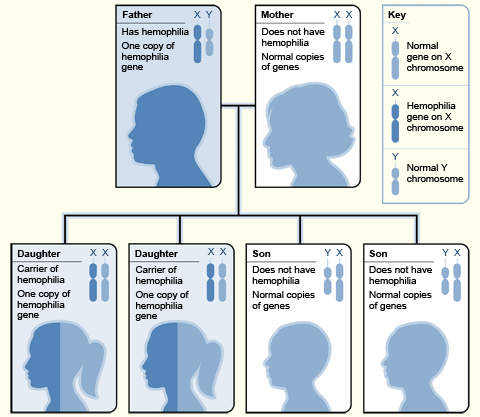What Causes Hemophilia?
If you have inherited hemophilia, you're born with the disorder. It's caused by a defect in one of the genes that determine how the body makes blood clotting factor VIII or IX. These genes are located on the X chromosomes (KRO-muh-somz).
Chromosomes come in pairs. Females have two X chromosomes, while males have one X and one Y chromosome. Only the X chromosome carries the genes related to clotting factors.
A male who has a faulty hemophilia gene on his X chromosome will have hemophilia. A female must have the faulty gene on both of her X chromosomes to have hemophilia, which is very rare.
If a female has the faulty gene on only one of her X chromosomes, she is a "hemophilia carrier.” Carriers don't have hemophilia, but they can pass the faulty gene to their children.
Below are two examples of how the hemophilia gene is inherited.
Inheritance Pattern for Hemophilia—Example 1

The image shows one example of how the hemophilia gene is inherited. In this example, the father doesn't have hemophilia (that is, he has two normal chromosomes—X and Y). The mother is a carrier of hemophilia (that is, she has one faulty X chromosome and one normal X chromosome).
Each daughter has a 50 percent chance of inheriting the faulty gene from her mother and being a carrier. Each son has a 50 percent chance of inheriting the faulty gene from his mother and having hemophilia.
Inheritance Pattern for Hemophilia—Example 2

The image shows one example of how the hemophilia gene is inherited. In this example, the father has hemophilia (that is, his X chromosome is faulty). The mother isn't a hemophilia carrier (that is, she has two normal X chromosomes).
Each daughter will inherit the faulty gene from her father and be a carrier. None of the sons will inherit the faulty gene from their father; thus, none will have hemophilia.
Females who are hemophilia carriers usually have enough clotting factors from their one normal X chromosome to prevent serious bleeding problems. However, up to
Very rarely, a girl is born with hemophilia. This can happen if her father has hemophilia and her mother is a carrier.
Some males who have the disorder are born to mothers who aren't carriers. In these cases, a mutation (random change) occurs in the gene as it is passed to the child.
Clinical trials are research studies that explore whether a medical strategy, treatment, or device is safe and effective for humans. To find clinical trials that are currently underway for Hemophilia, visit www.clinicaltrials.gov.
![]()
Visit Children and Clinical Studies to hear experts, parents, and children talk about their experiences with clinical research
December 10, 2011
Gene therapy helps patients with hemophilia B
An experimental gene therapy technique boosted the production of a vital blood clotting factor in six people with hemophilia B, according to new research supported by the National Institutes of Health.
The NHLBI updates Health Topics articles on a biennial cycle based on a thorough review of research findings and new literature. The articles also are updated as needed if important new research is published. The date on each Health Topics article reflects when the content was originally posted or last revised.
















